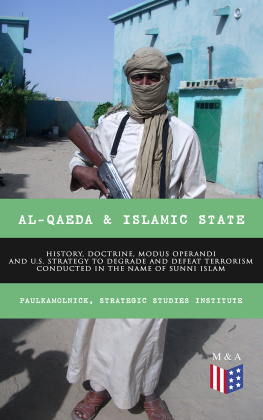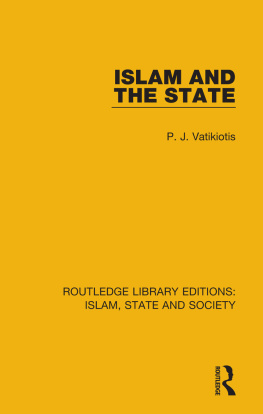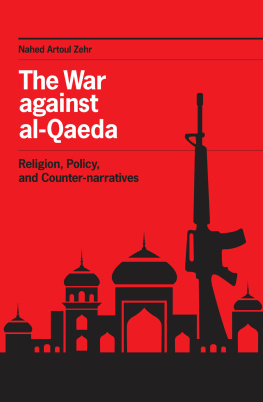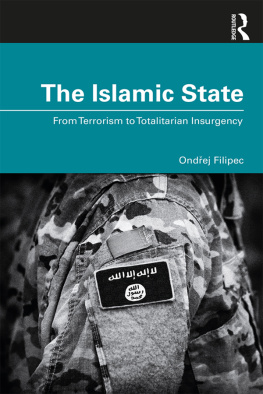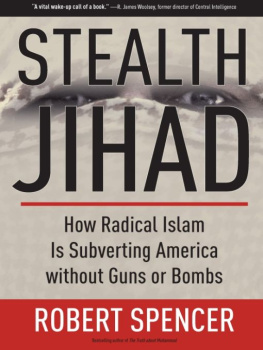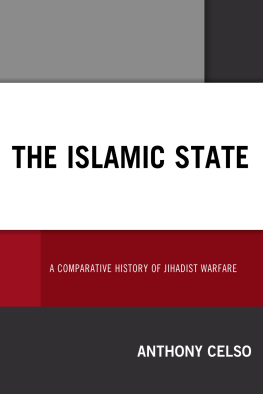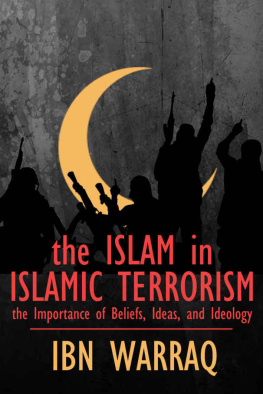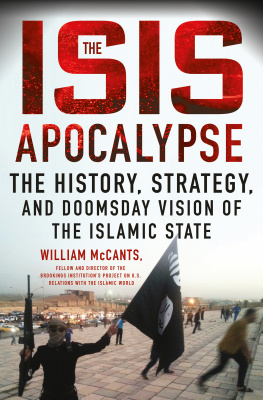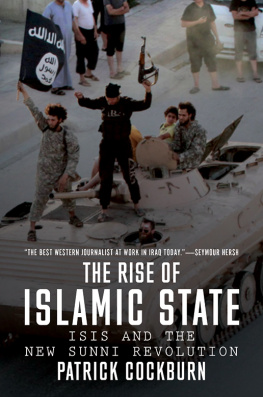Paul Kamolnick, Strategic Studies Institute
Al-Qaeda & Islamic State: History, Doctrine, Modus Operandi and U.S. Strategy to Degrade and Defeat Terrorism Conducted in the Name of Sunni Islam
Sunni Islamic Orthodoxy, Salafism, Wahhabism, Muslim Brotherhood, Base of the Jihad, Bin Laden, From the Islamic State to the Caliphate, Recommendations for U.S. Government
Madison & Adams Press, 2017. No claim to original U.S. Government Works
Contact
ISBN 978-80-268-7937-4
This is a publication of Madison & Adams Press. Our production consists of thoroughly prepared educational & informative editions: Advice & How-To Books, Encyclopedias, Law Anthologies, Declassified Documents, Legal & Criminal Files, Historical Books, Scientific & Medical Publications, Technical Handbooks and Manuals. All our publications are meticulously edited and formatted to the highest digital standard. The main goal of Madison & Adams Press is to make all informative books and records accessible to everyone in a high quality digital and print form.
FOREWORD
Dr. Kamolnicks book is a meticulously documented investigation and comparison of the al-Qaeda Organization (AQO) and the Islamic State Organization (ISO) across three key strategically relevant dimensions: essential doctrine, beliefs, and worldview; strategic concept, including terrorist modus operandi; and in the final chapter, specific implications, and recommendations for current U.S. Government policy and strategy. Through this comparison, he supplies far greater clarity on, incisive analysis of, and potential answers for such key questions as: How is each terrorist entity related historically and doctrinally to the broader phenomenon of transnational Sunni jihadism? What is the exact nature of the ISO? How, if at all, does ISO differ in strategically relevant ways from AQO? What doctrinal differences essentially define these entities? How does each understand and operationalize strategy? What critical requirements and vulnerabilities characterize each entity? Finally, what implications, recommendations, and proposals are advanced that are of particular interest to U.S. Government strategists and professional military educators?
Dr. Kamolnicks book substantially advances the knowledge and strategy pertinent to combating these terrorist entities more effectively. I highly recommend it.

DOUGLAS C. LOVELACE, JR.
Director
Strategic Studies Institute and
U.S. Army War College Press
SUMMARY
INTRODUCTION
It is declared U.S. Government (USG) policy to degrade, defeat, and destroy two transnational adversaries that conduct terrorism in the name of Sunni Islam: the al-Qaeda Organization (AQO) and the Islamic State Organization (ISO). The present book has been written to assist policymakers, military planners, strategists, and professional military educators to more effectively accomplish that objective. Chapter 1 documents the distinct history and doctrinal beliefs of each organization; Chapter 2 examines AQOs and ISOs basic strategic concept and terrorist modus operandi; and Chapter 3 recapitulates chief conclusions, considers strategic implications, and supplies select recommendations.
AQO and ISO claim to represent the true and abiding interests of the worlds Sunni Muslims (Ahl-us Sunnah), estimated to number 1.4 billion persons. This book finds that this is unsupported by the evidence. Instead, AQO and ISO may be conceived in the very terms of the Sunni Islam they themselves profess, as deviant criminal terrorist organizations guilty of committing reprehensible and forbidden acts, undermining Islamic interests, and besmirching rather than elevating Islam in the eyes of the non-Muslim world. A more optimistic prognosis for the future destruction of each entity is therefore warranted. The worlds Sunni Muslims must make that determination, however, and define for themselves where the bounds of faith, godly fear (taqwa), and righteous conduct begin and end; who may or may not legitimately claim to speak and act in their name; and who may or may not be deemed a genuine ally, fellow soldier, friend, or enemy in this historic endeavor.
CONCLUSIONS
Despite their common genus as violent transnational Sunni jihadist organizations, AQO and ISO are distinct species that substantially diverge in conceptions of doctrine and creed, strategy, and terrorist modus operandi. Doctrinally, the original AQO idea first arises in opposition to Palestinian-Jordanian Shaykh Dr. Abdallah Azzams conception of Sunni global jihadism. AQO shares with Azzamism a Sunni pan-Islamic ecumenical approach embodied in Azzams Muslim Brotherhood-Salafi-Wahhabi fusion. This mission is originally one of lumping, not splitting, Church not sect, openness not exclusivity, and emphasizes intra-Sunni solidarity, unity, community, brotherhood, and the tolerance of differences among all fighting elements willing to serve as force multipliers and allies within broader alliances in a now-fermenting Arab Muslim world.
AQO differs from Azzamism in two key respects. Osama bin Laden sought to create an autonomous bin Laden-led army; whereas Azzam viewed his role as one of assisting, complementing, and subordinating Arabic volunteers to the Afghan-led Islamic forces fighting against the Communist-installed and backed Afghan regime. Second, for Azzam, Palestine occupied a privileged theater of future near-term operations, whereas the original AQO, instead, de-privileged Palestine and conceived itself as an Arab-led transnational military expeditionary force, a type of Arabic jihadi Foreign Legion, serving as a force multiplier. Consequently, they deployed high-quality operatives with advanced training possessed of the AQO worldview, belief-system, and a desire to co-opt localized insurgencies into various AQO nodes, fighting to first win Islamic lands with the intent of reestablishing an Islamic Caliphate, and eventually launching a future offensive jihad against the original infidels.
The AQO ideas second chief opponent was jihadi takfirism, i.e., rigidly-extremist sectarians who extravagantly accuse other Muslims of apostasy (Ridda). Though bin Ladens emergent Base of the Jihad Organization (Tanzim Qaidat al-Jihad) viewed the Shia as a wayward and deviant sect, it did not at any time privilege a war against Shiism per se as the essential starting point for the purification and revivification of Sunni orthodoxy as a ruling imperium. Moreover, AQO in its training camps deliberately policed and opposed takfirism, and in its stead supplied indoctrination into the uniquely ecumenical AQO pan-Islamist Sunni jihadist vision of a vanguard Sunni armed organization whose singular mission was to unite disparate struggles into a broader transnational struggle to eventually restore a supranational Caliphal sovereign. The AQO idea is not exclusively Salafist, though it includes a significant number. It is not exclusively Salafi-Wahhabi or Wahhabi, though it also includes their number; it is not exclusively inspired by Sayyid Qutb, though he is recognized and honored as a pioneering jihadi thinker. It is rather a broad, transnational Church-like conglomerate whose vision, values, and mission statement prohibit extremely strict Muslimness tests or other instruments designed to split into ever-smaller numbers those considered virtuous enough to wage a united Sunni war against the occupying Crusaders of Muslim lands.

